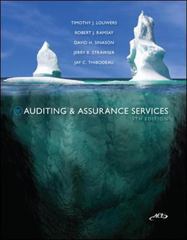Question
I got the first question. I am having trouble on questions 5. The answer for what regression equation to use for Question 1 is: Overhead
I got the first question. I am having trouble on questions 5.
The answer for what regression equation to use for Question 1 is:
Overhead = 1,732.06012 + 81.92799 * Number of Setups + 4.21711 * Machine Hours
Sorrentino Company, which has been in business for one year, manufactures specialty Italian pastas. The pasta products start in the mixing department, where durum flour, eggs, and water are mixed to form dough. The dough is kneaded, rolled flat, and cut into fettucine or lasagna noodles, then dried and packaged.
Paul Gilchrist, controller for Sorrentino Company, is concerned because the company has yet to make a profit. Sales were slow in the first quarter but really picked up by the end of the year. Over the course of the year, 717,500 boxes were sold. Paul is interested in determining how many boxes must be sold to break even. He has begun to determine relevant fixed and variable costs and has accumulated the following per unit data:
Price $0.95
Direct materials 0.35
Direct labor 0.25
| He has had more difficulty separating overhead into fixed and variable components. In examining overhead-related activities, Paul has noticed that machine hour appear to be closely correlated with units in that 100 boxes of pasta can be produced per machine hour. Setups are important batch-level activity. Paul also thinks that indirect labor hour may be associated with the overhead expense, but there is no evidence showing the relation. Currently, indirect labor hour is scheduled to be 2000 hours per year. Paul has accumulated the following information on overhead costs, number of setups, machine hours, and indirect labor hours for the past 12 months. Month | Overhead | Number of Setups | Machine Hours | Indirect Labor Hours |
| January | $5,700 | 18 | 595 | 155 |
| February | 4,500 | 6 | 560 | 135 |
| March | 4,890 | 12 | 575 | 125 |
| April | 5,500 | 15 | 615 | 200 |
| May | 6,320 | 20 | 680 | 240 |
| June | 5,100 | 10 | 552 | 183 |
| July | 5,532 | 16 | 630 | 205 |
| August | 5,409 | 12 | 600 | 115 |
| September | 5,300 | 11 | 635 | 162 |
| October | 4,950 | 12 | 525 | 145 |
| November | 5,350 | 14 | 593 | 185 |
| December | 5,600 | 14 | 615 | 150 |
Selling and administrative expenses, all fixed, amounted to $200,000 last year.
In the second year of operations, Sorrentino Company has decided to expand into the production of sauces to top its pastas. Sauces are also started in the mixing department, using the same equipment. The sauces are mixed, cooked, and packaged into plastic containers. One jar of sauce is priced at $2 and required $0.65 of direct materials and ACC320 Group Project 1CVP and Regression Analysis
$0.45 of direct labor. 60 jars of sauce can be produced per machine hour. The production manager believes that with careful scheduling, he can keep the total number of setups and total number of indirect labor hours (for both pasta and sauce) to the same number as used last year. The marketing director expects to increase selling expense by $30,000 per year to promote the new product and believes Sorrentino Company can sell three boxes of pasta for every one jar of sauce.
Required:
1. Separate overhead into fixed and variable components using regression analysis. Run seven regressions by using different combinations of three independent variables: number of setups, machine hours, and indirect labor hours. These seven regressions are: a) three simple regressions; b) three multiple regressions using two independent variables; c) multiple regression using all independent variables. Which regression equation is the best? Why?
Now, the best regression equation is chosen, use it to answer the following questions:
2. Calculate the number of boxes of pasta which must be sold to break even before the expansion into the production of sauces.
3. Now consider the production of sauces, calculate the break-even number of boxes of pasta and jars of sauce.
4. Suppose that the production manager is wrong and that the number of setups doubles. Calculate the new break-even number of boxes of pasta and jars of sauce.
5. Refer to the original data. Suppose that only 40 jars of sauce can be produced per machine hour and that Sorrentino Company will sell two boxes of pasta for every one jar of sauce. Calculate the new break-even number of boxes of pasta and jars of sauce.
6. Comment on the effects of the shift in sales mix and uncertainty in the cost estimation on the break-even points for Sorrentino Company.
Step by Step Solution
There are 3 Steps involved in it
Step: 1

Get Instant Access to Expert-Tailored Solutions
See step-by-step solutions with expert insights and AI powered tools for academic success
Step: 2

Step: 3

Ace Your Homework with AI
Get the answers you need in no time with our AI-driven, step-by-step assistance
Get Started


